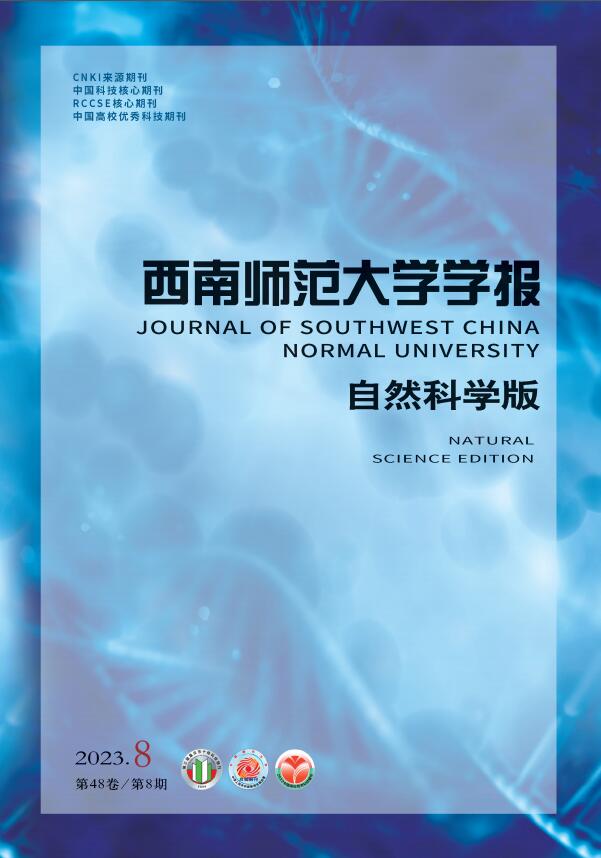-
考虑如下方程:
其中Ω⊂
$\mathbb{R}^3$ 是光滑的有界区域,a,ε,λ>0,fλ=λf++f-∈L∞(Ω),f±=±max{± f,0}$\not \equiv$ 0,1 < q < 2,0≤s < 1,2*(s)=2(3-s)是临界Sobolev-Hardy指数,$\|u\|^{2}=\left(\int_{\mathit{\Omega}}|\nabla u|^{2} \mathrm{~d} x\right)^{\frac{1}{2}}$ .长期以来,学者们研究了如下Kirchhoff方程:
其中Ω是
${{\mathbb{R}}^{N}}$ (N≥3)上的有界光滑区域,a,b,λ>0. 这类方程解的存在性与多重性一直受到很多学者的关注[1-8]. 特别地,文献[9]研究了如下一类带变系数项的超线性Kirchhoff方程:其中Ω是
${{\mathbb{R}}^{N}}$ (N≥3)上的有界光滑区域,a是常数,m,f:${{\mathbb{R}}_{+}}\to {{\mathbb{R}}_{+}}$ 是连续函数. 当ε充分小时,通过变分法和迭代法,文献[9]得到了方程(3)至少有一个正解. 对于m=1,文献[10]考虑了临界项和凹凸非线性项问题,通过变分法和集中紧性原理得到了方程(3)至少有两个正解.据我们所知,涉及临界Sobolev-Hardy指数的情形没有结果,为此我们研究该情形,并给出相关结果:
定理1 设a>0,0≤s < 1,1 < q < 2,fλ∈L∞(Ω),则当ε>0充分小时,存在λ* >0使得对∀λ∈(0,λ*),方程(1)至少存在两个正解.
HTML
-
记
$|u{{|}_{p}}={{\left({{\int_{\mathit{\Omega }}{\left| u \right|}}^{p}}~\text{d}x \right)}^{\frac{1}{p}}}$ 和${\left| u \right|_\infty } = \mathop {\sup }\limits_{x \in \mathit{\Omega }} {\mkern 1mu} \left\{ u \right\}$ . Br和∂Br分别是以0为圆心,以r为半径的闭球和球面. un±(x)=max{±un,0}. C1,C2,C3,…是正常数.是Sobolev最佳嵌入常数. 如果对∀φ∈H01(Ω),
则称u是方程(1)的解. 众所周知,方程(1)对应的能量泛函为
其临界点是方程(1)的解.
引理1 若定理1的条件成立,则存在常数R,ρ,Λ0>0,使得对∀λ∈(0,Λ0),
$\inf\limits _{u \in \overline{B_{R}}} I_{\lambda}(u) < 0$ ,$\left.I_{\lambda}(u)\right|_{u \in \partial B_{R}}>\rho$ .证 由Sobolev嵌入定理知,存在C>0,使得
$\int_{\mathit{\Omega}} u^{q} \mathrm{d} x \leqslant C \int_{\mathit{\Omega}}|\nabla u|^{2} \mathrm{d} x(1 \leqslant q \leqslant 6)$ .令
$g(t)=\frac{a}{2} t^{2-q}-\frac{1}{2^{*}(s)} S^{-\frac{2^{*}(s)}{2}} t^{2^{*}(s)-q}$ ,则存在正常数R,使得$g(R)={\max\limits _{t>0}}g(t)>0$ ,记${{\mathit{\Lambda }}_{0}}=\frac{qg(R)}{2C{{\left| {{f}_{+}} \right|}_{\infty }}}$ ,对∀λ∈(0,Λ0),存在常数ρ>0,有$\left.I_{\lambda}(u)\right|_{u \in \partial B_{R}}>\rho$ .根据文献[11]中引理3.1,存在φ0∈C0∞(Ω),使得
$\int_{\mathit{\Omega}} f_{\lambda}(x)\left(\varphi_{0}^{+}\right)^{q} \mathrm{d} x>0$ . 由1 < q < 2知,当t充分小时,Iλ(tφ0) < 0. 因此,$d=\inf \limits_{u \in B_{R}} I_{\lambda}(u) < 0$ .定理2 若定理1的条件成立,则∀λ∈(0,Λ0),方程(1)存在正解u1,满足I(u1) < 0.
证 由引理1知,对任意的λ∈(0,Λ0),
$d=\inf\limits _{u \in B_{R}} I_{\lambda}(u) < 0 < \inf \limits_{\|u\|=R} I_{\lambda}(u)$ . 由于BR是闭凸集,在BR上运用Ekeland变分原理,获得Iλ的一个局部极小解u1. 对∀ψ∈H01(Ω),让t>0足够小,使得u0±tψ∈BR,有$\lim \limits_{t \rightarrow 0} \frac{I_{\lambda}\left(u_{1} \pm t \psi\right)-I_{\lambda}\left(u_{1}\right)}{t} \geqslant 0$ . 故在(6)式中取测试函数ψ=-u1-,通过计算得‖u1-‖=0,这意味着u1≥0. 因此,u1是方程(1)的非负非平凡解. 根据强极大值原理可得u1>0. 因此,u1是方程(1)的正解且Iλ(u1)=d < 0.
-
引理2 若定理1的条件成立,则当λ∈(0,Λ0)时,对于给定的R0>0,存在v0∈H01(Ω)且‖v0‖>R0,使得Iλ(v0) < 0.
证 对∀t>0,
由0≤s < 1知,2*(s)>4. 因此,当t+∞时,Iλ(tu)-∞. 故存在v0∈H01(Ω)满足‖v0‖>R0,使得Iλ(v0) < 0.
引理3 若定理1的条件成立,则当
$c < c^{*}=\left(\frac{1}{2}-\frac{1}{2^{*}(s)}\right)(a S)^{\frac{3-s}{2-s}}-D \lambda^{\frac{2}{2-q}}$ 时,Iλ满足(PS)c条件,其中$D=\left(\frac{4-q}{4 q}\left|f_{+}\right|_{\infty} C\right)^{\frac{2}{2-q}}\left(\frac{2 q}{a}\right)^{\frac{2}{2-q}}$ ,C为引理1中提到的常数.证 令{un}⊂H01(Ω)是Iλ的一个(PS)c序列,当n→∞时,有
根据Sobolev嵌入定理和(7)式,有
由1 < q < 2 < 2*(s)知,{un}⊂H01(Ω)有界. 因此,存在其子列(仍记为{un})和u0∈H01(Ω),使得在H01(Ω)上,有un⊂u0;在L2*(s)(Ω,|x|-sdx)上,有un
$\rightharpoonup$ u0;在Lp(Ω)(1≤p < 2*(s))上,有un→u0;在Ω上几乎处处有un(x)→u0(x). 利用集中紧性引理和Sobolev-Hardy不等式,有其中J是一个至多可数的指标集,δxj是在xj上的Dirac测度. 我们可以找到序列{xj}⊂Ω, μj,νj,使得
接下来,证明J=Ø. 假设J≠Ø,对ε>0,设ψε,j(x)∈C0∞满足条件0≤ψε,j≤1,
$\left|\nabla \psi_{\varepsilon, j}(x)\right| \leqslant \frac{4}{\varepsilon}$ ,当$x \in B\left(x_{j}, \frac{\varepsilon}{2}\right)$ 时,ψε,j=1,当x∈B(xj,ε)时,ψε,j=0. 根据(4)式,可知由{un}有界知,
$\lim \limits_{\varepsilon \rightarrow 0} \lim \limits_{n \rightarrow \infty} \int_{{\mathit{\Omega}}} f_{\lambda}\left(u_{n}^{+}\right)^{q-1} \psi_{\varepsilon, j}(x) u_{n} \mathrm{d} x=0$ . 由于{ψε,jun}在H01(Ω)上有界,则(Iλ′ (un),ψε,jun)→0. 因此结合(8)式,可推得:(ⅰ)
$\mu_{j} \geqslant\left(a S^{\frac{2^{*}(s)}{2}}\right)^{\frac{2}{2^{*}(s)-2}}=a^{\frac{3}{2-s}} S^{\frac{3-s}{2-s}}$ ,或者(ⅱ) μj=νj=0. 下面证明(ⅰ)不成立. 由(7)式和Young不等式,可推出此与c < c*是矛盾的. 故μj=νj=0,即J=Ø,这意味着当n→∞时,
$\int_{\mathit{\Omega}} \frac{\left|u_{n}\right|^{2^{*}(s)}}{|x|^{s}} \mathrm{~d} x \rightarrow \int_{\mathit{\Omega}} \frac{\left|u_{0}\right|^{2^{*}(s)}}{|x|^{s}} \mathrm{~d} x$ . 可推出{un}在H01(Ω)上强收敛于u0.定义
其中C3(s)为与s有关的常数,Uε(x)是方程
$-\Delta U_{\varepsilon}=U_{\varepsilon}^{5}\left(x \in \mathbb{R}^{3}\right)$ 的解,并且满足$\int_{\mathbb{R}^{3}}\left|U_{\varepsilon}\right|^{6} \mathrm{~d} x=\int_{\mathbb{R}^{3}}\left|\nabla U_{\varepsilon}\right|^{2} \mathrm{~d} x={{S}^{\frac{3}{2}}}$ . 令η∈C0∞(Ω)满足条件0≤η≤1,|▽η|≤C,且当|x| < R0时,η(x)=1;|x|>2R0时,η(x)=0. 设uε(x)=η(x)Uε(x),有引理4 若定理1的条件成立,则存在λ1>0,当λ∈(0,λ1)时,
$\sup\limits _{t \geqslant 0} I_{\lambda}\left(u_{1}+t u_{\varepsilon}\right) <c^{*}$ .证 对p,q>0,有
从定理2的证明,不难看出u1是有界的. 因此,存在M>0,使得‖u1‖ < M. 注意到Iλ(u1) < 0,由(12)式、Hölder不等式和Young不等式知
利用文献[10]的方法知,存在tε>0和与ε,λ无关的常数t1,t2,满足0 < t1≤tε≤t2 < ∞,使得
$\sup \limits_{t \geqslant 0} J\left(t u_{\varepsilon}\right)$ =J(tεuε). 根据(10)式,我们得到注意到
$\int_{\mathit{\Omega }}{u_{\varepsilon }^{q}}\text{d}x\le {{C}_{8}}{{\varepsilon }^{\frac{q}{2}}}$ ,由(11)和(13)式知记
$\varepsilon=\lambda^{\frac{4}{q(2-q)}}$ , 当$0 < \lambda < \lambda_{1}=\left(\frac{C_{12}}{C_{9}+D}\right)^{q(2-s)}$ 时,有即
因此
$\sup \limits_{t \geqslant 0} I_{\lambda}\left(u_{1}+t u_{\varepsilon}\right) < c^{*}$ .定理3 若定理1的条件成立,则存在λ*>0,使得∀λ∈(0,λ*),方程(1)有一个正解u2,并且满足Iλ(u2)>0.
证 令λ*=min{Λ0,λ1},当0 < λ < λ*时,由引理1和2知,Iλ(u)具有山路几何结构. 令
由引理3和引理4知c < c*,且Iλ(u)满足(PS)c条件. 由山路引理[12-13]获得方程(1)的非平凡解u2满足Iλ(u2)>0. 类似定理2的论述,不难得到u2是方程(1)的一个正解.
定理1的证明由定理2和定理3知,方程(1)有两个正解u1和u2,满足Iλ(u1) < 0 < Iλ(u2).






 DownLoad:
DownLoad: